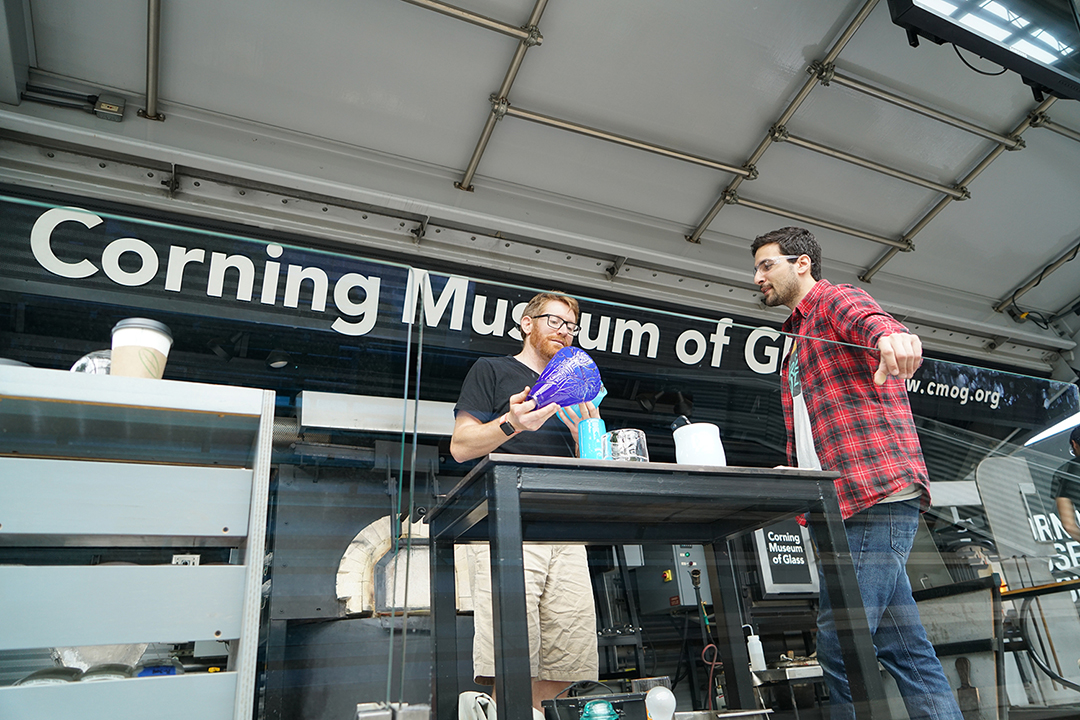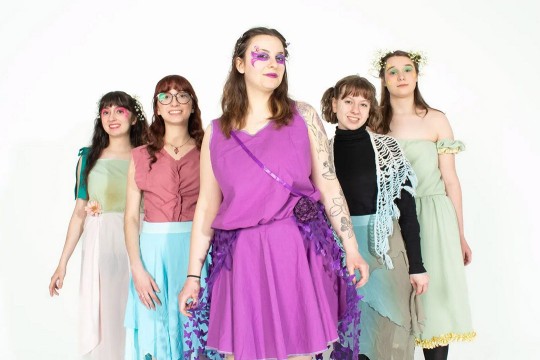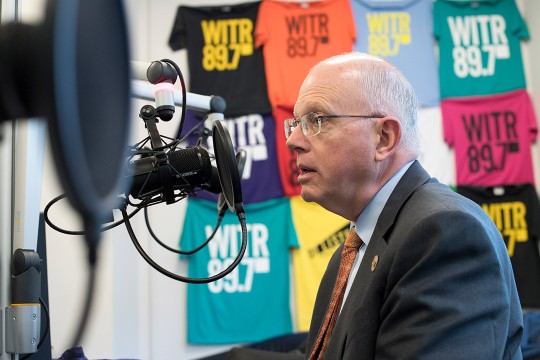Industrial design alumnus earns exploratory experience at Corning Museum
Michaela Dann
David Villarreal, right, worked with professional glassblowers June 6-7 at Corning Museum of Glass
David Villarreal’s time at Rochester Institute of Technology was filled with success and taking advantage of multidisciplinary opportunities to ideate and create solutions. So it’s fitting the recent graduate of RIT’s industrial design MFA program received the 2018 GlassLab Design Fellowship.
Sponsored annually by Corning Museum of Glass (CMoG), the fellowship grants a graduating RIT industrial design (BFA) senior or graduate student a distinctive two-day session. The award winner works with professional artists at the museum torapidly prototype concepts and use the immediacy of hot glass as a catalyst for innovation.
Villarreal spent June 6-7 at CMoG articulating the spans of his imagination and bringing ideas to life. He and a team of CMoG glassblowers focused on several concepts of design, including using peeling and bifurcations techniques.
“I wanted it to be as much about what they might want to try as it was what I wanted to make,” Villarreal said. “I think at the very least we were successful in making it a learning experience for all parties involved.”
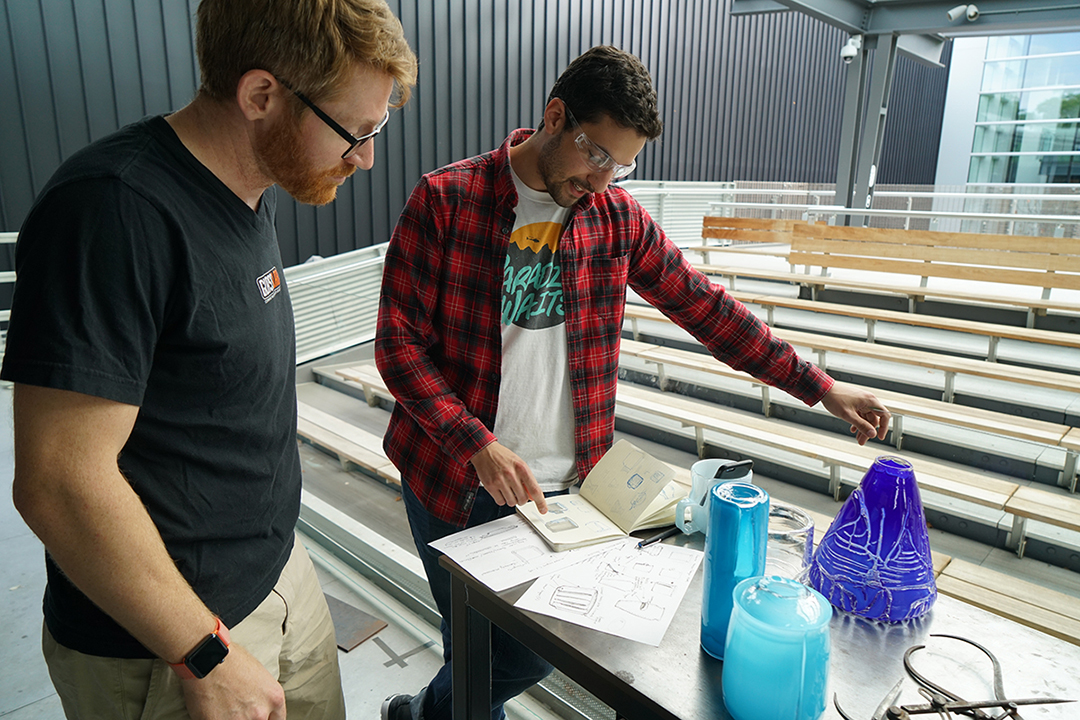
The GlassLab Fellowship is a prestigious opportunity given annually to an outstanding student selected by a faculty panel from the RIT industrial design MFA program. The prototypes completed throughout the experience are housed and displayed in a special exhibit that is occasionally open to the public.
CMoG’s GlassLab design program has permitted many prolific designers the chance to explore concepts in glass through collaborative workshops with glassmakers. One such designer is Josh Owen, the RIT industrial design professor and program chair who announced Villarreal as this year’s fellowship winner.
Villarreal graduated from RIT’s motion picture science program in 2014 and worked in the film industry before returning to RIT for graduate school. Below, find out more about his enriching experience at RIT, which culminated in the workshop at CMoG.
Question: What was your GlassLab Design Fellowship experience at CMoG like?
David Villarreal: The experience definitely exceeded my expectations.The CMoG staff was amazing. They were encouraging and accommodating to anything, no matter how unorthodox, I wanted to try.It was awesome being able to see my designs come to life right in front of me, and handmade out of hot molten glass, no less. It is always fun to work with new personalities and materials and to see what things you can bring to the table as a collective as far as design is concerned.
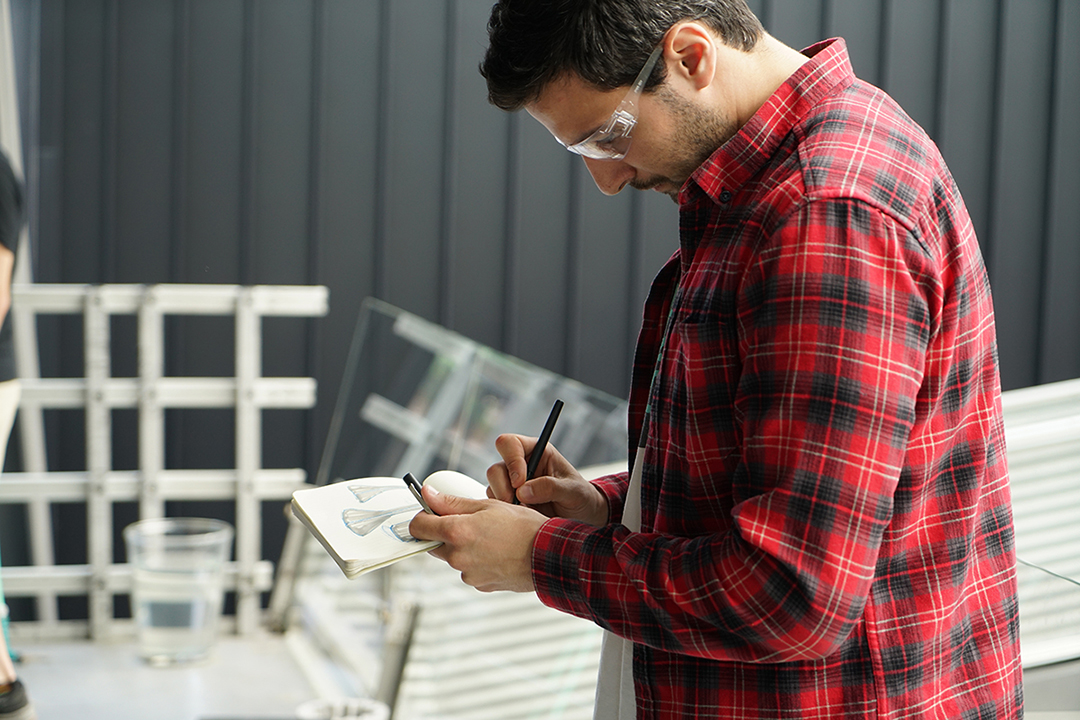
Question: How did it feel to be selected to participate in such a prestigious fellowship?
DV: I guess I never thought I would win an award like this because there are a lot of big names that have participated in the past so it was kind of intimidating.I can’t thank RIT, all the CMoG staff and the gaffers, Dane (Jack) and Jared (Rosenacker), enough for all of their support and providing me with this opportunity. It’s an experience I won’t forget. We were able to really focus on a few concepts and have fun with the exploration.
Question: Describe some of the projects you worked on. How did they turn out?
DV: I really wasn’t entirely interested in the end result of the pieces, but more in what insights the process could give us. We experimented a lot with cracking a blown-glass vessel randomly and then blowing a stuff cup into the slightly cooled, cracked-glass vessel, giving the exterior vessel a textured skin that resembled mountain ranges. To take this further we tried to play around with controlling the cracks on the glass vessels as they were being blown, scoring shapes that could become potential handles or interesting bifurcations. It took a lot of improvising on the spot. In the end it was just really interesting trying things that would otherwise be considered blasphemous and/or terrible technique in the glass world.
Question: What are your plans now?
DV: I am interning with Josh Owen this summer and then I will be moving to Denver, Colo., in August. I am currently actively pursuing and interviewing out there. I got heavily involved in accessible technology (at RIT) and there is a lot of that out there as far as big impacts and funding for providing solutions for people with limited mobility. If I could get into something like prosthetics for athletes, that would be really cool, or even just outdoor equipment.
Question: What peaked your interest in accessible technology?
DV: In graduate school I took advantage of the opportunities that were available, such as (RIT’s) Simone Center for Innovation and Entrepreneurship and Studio930. Through the Simone Center I became involved in a workshop called IdeaLab. Basically, it’s a biannual event where students from multiple disciplines ideate and rapid prototype ideas together to create solutions for problems that were given, usually in the realm of medical technologies and accessible technologies. You’re given 24 to 36 hours to come up with solutions and present them. A lot of these projects, if the students chose, could continue beyond IdeaLab, so that’s what I did and I’m still working on a project from when I participated in that a couple of years ago.
Question: What was your favorite project that you worked on throughout your time at RIT?
DV: I was part of a multidisciplinary team of engineers and design students in IdeaLab that was focused on designing a lifting system that would reduce physical strain on adaptive sports ski instructors transferring people with limited mobility from a sit ski to a wheelchair while also creating a better experience for those being lifted. The outcome was a vest that can be used manually or in conjunction with a lift that gives the instructors better lifting positions and sit ski participants the opportunity to lift themselves, allowing for much safer and more dignified transfers. We called it LEV, for Lifting Ergonomic Vest. It’s something that’s often overlooked. We should be designing systems like these as a whole — not just focusing on the main activity, but all aspects of the experience.
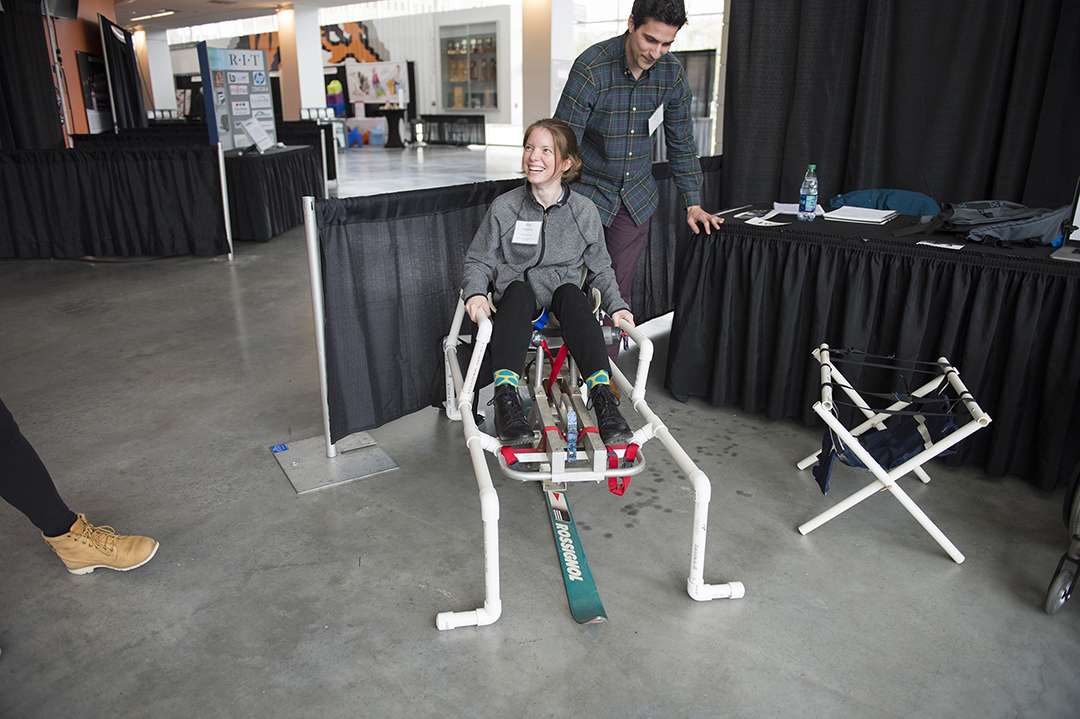
Question: What was RIT’s impact on you as a designer?
DV: RIT definitely teaches you how to work hard. It gives you this drive and endurance to chunk out problems and problem-solve effectively. From my undergrad to graduate program I was given a lot of freedom to do what I wanted and the opportunities are right there. If you want to learn something, from any discipline, you had to opportunity to do that.
Question: What advice would you give to future students of the industrial design program?
DV: Be open to new things early on. Be open to new experiences. Don’t be afraid to make a change, change majors, or pivot your focus. Design, in general, should be seen as a holistic way to problem-solve. Everything can impact the way you see a problem that needs to be solved, whether you know it or not. Just be open to new things and ideas and don’t be so focused on one particular way to approach. You have to take risks.










